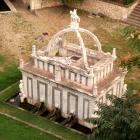Ulrich Pfisterer has taught art history at the Ludwig-Maximilians- Universität in Munich since 2006. He received his PhD from the University of Göttingen (1997) and undertook his ‘Habilitation’ at the University of Hamburg (2006). Fellowships allowed him to work at the Bibliotheca Hertziana in Rome, the Kunsthistorisches Institut in Florence, the Herzog August Bibliothek in Wolfenbüttel, the Getty Research Center in LA and at CASVA/National Gallery of Art in Washington. His interests encompass the fields of early modern art in Europe and beyond as well as the methodology and historiography of art history. In 2012 he co-organized an exhibition on ‘Ideals and Idols’ which thematized the reception of non-European reglious artifacts in 15th- to 18th- century European books and book illustrations up to the publications of Montfaucon, Picart and Lafitau. He is directing two research projects on the ‘episteme of lines’ and drawing books from c. 1525–1925 and on concepts and images of the ruler’s body in early modern Europe. Ulrich has published books on – among others – Donatello, art literature and theory in the Italian Renaissance, the social uses of Renaissance medals in Italy, the Sistine Chapel and on ‘birthing art’ which deals with the relation of concepts of erotic and biological procreativity and artistic creativity in early modern Europe. He is also the general editor of the collected writings of Aby Warburg, for which he has co-edited the volume on Fragmente zur Ausdruckskunde (2015). Currently he is preparing a collected volume of global artistic exchange and contact zones c.1300-1650.


